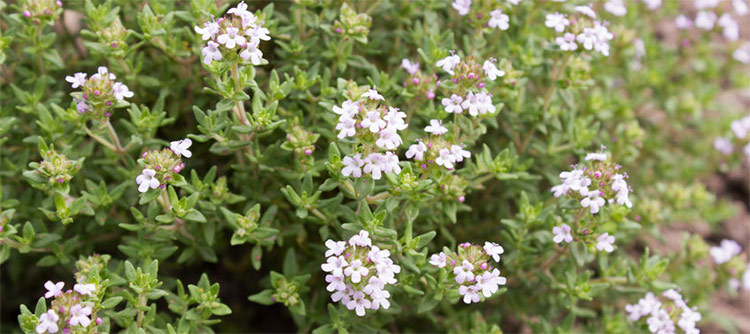Thyme Essential Oil
Thymus vulgaris/ Thymus zygis

Description
Historically, fresh and dried Thyme as well as the essential oil have been used to help ward off bacteria and viruses. Of the most commonly available Thyme Essential Oils, Thyme ct linalool tends to be amongst the most gentle and safe while Thyme ct thymol contains more thymol and can be a more potent antibacterial/antiviral oil.
Constituent and safety information varies depending on the specific chemotype of Thyme Oil used.

Some companies offer a "benchmark" Thyme Essential Oil that combines several thyme chemotypes. Benchmark Thyme Essential Oil is gaining attention for its potential in combating MRSA.
Thyme Essential Oil Benefits and Uses
Within Aromatherapy vs MRSA, Maggie Tisserand identifies and discusses Thyme as one of the three key essential oils that have the potential to combat MRSA.
- Arthritis
- Colds
- Cuts
- Dermatitis
- Flu
- Insect Bites
- Laryngitis
- Lice
- Muscle Aches
- Oily Skin
- Poor Circulation
- Scabies
- Sore Throat
Source: Julia Lawless, The Encyclopedia of Essential Oils (Updated Edition) (London: Harper Thorsons, 2014), 191-192.
Botanical Name
Plant Family
Common Method of Extraction
Steam Distilled
Plant Part Typically Used
Color

Pale Yellow
(May Vary, Depending on Specific Botanical, Chemotype and Distillation)
Consistency
Medium and Slightly Oily
Perfumery Note
Middle
Strength of Initial Aroma
Medium - Strong
Aromatic Description
Thyme Essential Oil smells fresh, herbaceous and slightly medicinal.
Sustainability and Conservation Status
Least Concern
Source: https://www.iucnredlist.org/species/203348/2764289
To learn more about the conservation status of essential oil bearing plants and how to use the IUCN Red List of Threatened Species, please refer to AromaWeb's Guide to Essential Oils and Sustainability.
Thyme (Thymus vulgaris, ct thymol) Major Constituents
- Thymol
- p-Cymene
- Carvacrol
- Gamma-Terpinene
- B-Caryophyllene
- Linalool
- a-Pinene
- a-Terpinene
See Essential Oil Safety for more complete list of typical constituents.
Source: B.M. Lawrence, Progress in Essential Oils. (Perfumer & Flavorist 20 no. 3, 1995), 67. B.M. Lawrence, Progress in Essential Oils. (Perfumer & Flavorist 23 no. 1, 1998), 42-46. Source cited in Robert Tisserand and Rodney Young, Essential Oil Safety (Second Edition. United Kingdom: Churchill Livingstone Elsevier, 2014), 452-453.
Thyme (Thymus vulgaris, ct thymol) Safety Information
Tisserand and Young indicate that there is moderate risk for mucous membrane irritation, it may inhibit blood clotting and pose a drug interaction hazard. There is a low risk of skin sensitization, and Tisserand and Young recommend a dermal maximum of 1.3%. Reading Tisserand and Young's full profile is recommended. [Robert Tisserand and Rodney Young, Essential Oil Safety (Second Edition. United Kingdom: Churchill Livingstone Elsevier, 2014), 452-454.]
Thyme (Thymus zygis, ct linalool) Major Constituents
- Linalool
- Linalyl Acetate
- a-Terpineol+borneol
- Thumo
- p-Cymene
- B-Caryophyllene
- Camphene
- Carvacrol
- B-Mycrene
Source: B.M. Lawrence, Essential Oils 1981-1987 (Wheaton: Allured Publishing, 1989), 106. A. Velasco-Neguerela, M.J. Perez-Alonso. Nuevos Datos Sobre la Composicion Quimica de Aceites Essenciales Procedentes de Tomillos Ibericos. (Botanica Complutensis 16, 1990), 91-97. Sources cited in Robert Tisserand and Rodney Young, Essential Oil Safety (Second Edition. United Kingdom: Churchill Livingstone Elsevier, 2014), 451.
Thyme (Thymus zygis, ct linalool) Safety Information
Tisserand and Young do not indicate any special precautions when using Thyme ct linalool. Reading Tisserand and Young's full profile is recommended. [Robert Tisserand and Rodney Young, Essential Oil Safety (Second Edition. United Kingdom: Churchill Livingstone Elsevier, 2014), 451.]
Refer to the second edition of Essential Oil Safety for coverage of other Thyme Oil chemotypes.
General Safety Information
Do not take any oils internally and do not apply undiluted essential oils, absolutes, CO2s or other concentrated essences onto the skin without advanced essential oil knowledge or consultation from a qualified aromatherapy practitioner. For general dilution information, read AromaWeb's Guide to Diluting Essential Oils. If you are pregnant, epileptic, have liver damage, have cancer, or have any other medical problem, use oils only under the proper guidance of a qualified aromatherapy practitioner. Use extreme caution when using oils with children and be sure to first read the recommended dilution ratios for children. Consult a qualified aromatherapy practitioner before using oils with children, the elderly, if you have medical issues or are taking medications. Before using this or any essential oil, carefully read AromaWeb's Essential Oil Safety Information page. For in-depth information on oil safety issues, read Essential Oil Safety by Robert Tisserand and Rodney Young.
Shelf Life
Important Information About the Profiles
The essential oil information provided on AromaWeb is intended for basic educational purposes only. The references to safety information, test results, constituents and percentages is generalized information. Essential oils can vary greatly in composition. The data is not necessary complete and is not guaranteed to be accurate. The essential oil photos are intended to represent the typical and approximate color of each essential oil. However, essential oil composition and color can vary based on harvesting, distillation, age of the essential oil and other factors. Profiles for several CO2 Extracts and absolutes are included within the directory, and are denoted as such.
